Recovery Behavior of Fe-Based Shape Memory Alloys under Different Restraints
Abstract
1. Introduction
2. Production of the Fe-SMA
3. Experimental Program
3.1. Test Specimen
3.2. Direct Tensile Test
3.3. Pre-Straining Method
3.4. Activation Method
3.4.1. Free Restraint
3.4.2. Rigid Restraint
3.4.3. Partial Restraint
4. Result and Discussion
4.1. Mechanical Properties of Fe-SMA
4.2. Fe-SMA Behavior under Free Restraint
4.3. Fe-SMA Behavior under Rigid Restraint
4.3.1. Effect of Pre-Straining
4.3.2. Effect of Heating Temperature
4.4. Fe-SMA Behavior under Partial Restraint
5. Conclusions
- (1)
- While the ultimate strain in the FSMA-A specimen was 0.2256, which is about 75% less than the strain from FSMA-B and FSMA-C specimen, the yield strength estimated used 0.2% of the offset method in FSMA-A specimen. It was 599 MPa which is nearly 34% higher than the strength from FSMA-B and FSMA-C specimen. The elastic modulus calculated from FSMA-A, FSMA-B and FSMA-C specimen varied between 123 and 126 GPa and the effect of chemical composition was insignificant to the mechanical property.
- (2)
- Under the free restraint, the recovery strains are 0.00956, 0.01445, and 0.01977 for FSMA-A, FSMA-B, FSMA-C specimens after activation. Although the chemical composition in the FSMA-B and FSMA-C specimens are the same, the recovery strain differed by more than 37%. Accordingly, the heat treatment is proposed to have a high recovery strain in the Fe-based SMAs.
- (3)
- Under the rigid restraint, the effects of pre-strain in the FSMA-A, FSMA-B and FSMA-C specimens was insignificant compared to the final recovery stress when the Fe-SMA was activated. The recovery stress increased as the heating temperature was raised. Also, the FSMA-A has the higher the recovery stress than that of FSMA-B and FSMA-C. Also, FSMA-A has the less the short-term relaxation was formed than FSMA-B and FSMA-C.
- (4)
- In cases where the recovery strain developed when the Fe-SMA was activated and constrained in the same condition, the recovery stress in the FSMA-A specimen was greater than the one from the FSMA-C specimen. Thus, the FSMA-A type is suitable to be applied to a component, such as pre-stressing tendons, which requires a high recovery stress over a FSMA-C type.
- (5)
- In the case that the recovery strain developed when the Fe-SMA was activated and constrained in the same restraint condition, the recovery strain in the FSMA-C specimen was greater than the one from the FSMA-A specimen. Therefore, the FSMA-C type is applicable for use in pipe joining that encourages the component to have a high recovery strain.
- (6)
- The recovery stress in the FSMA-A and FSMA-C specimen constrained during cooling was 50% lower than those from the rigid restraint. Hence, constraining the deformation before the heating temperature is favorable in order to develop a high recovery stress.
- (7)
- When FSMA-C is used for the pipe coupler, the internal diameter of coupler should not be larger than 102% of the external diameter of connected pipe. Additionally, in order to develop an effective confining stress more than 50% or more of its recovery stress, the internal diameter of FSMA-C coupler should not be larger than 101.6% of the external diameter of connected pipe.
Author Contributions
Funding
Acknowledgments
Conflicts of Interest
References
- Lee, W.J.; Weber, B.; Leinenbach, C. Recovery stress formation in a restrained Fe–Mn–Si-based shape memory alloy used for prestressing or mechanical joining. Constr. Build. Mater. 2015, 95, 600–610. [Google Scholar] [CrossRef]
- Leinenbach, C.; Kramer, H.; Bernhard, C.; Eifler, D. Thermo-mechanical properties of an Fe-Mn-Si-Cr-Ni-VC shape memory alloy with low transformation temperature. Adv. Eng. Mater. 2012, 14, 62–67. [Google Scholar] [CrossRef]
- Kim, H. Pullout Behavior of Shape Memory Alloy Fiber Embedded in Mortar Matrices. Mater’s Thesis, Sejong University, Seoul, Korea, 2015. [Google Scholar]
- Hartl, D.J.; Mabe, J.H.; Benafan, O.; Coda, A.; Padan, R.; Van Doren, B. Standardization of shape memory alloy test methods toward certification of aerospace applications. Smart Mater. Struct. 2015, 24, 082001. [Google Scholar] [CrossRef]
- Park, N.J.; Park, S.B.; Cheong, C.C. Vibration and position tracking control of a smart structure using SMA actuators. J. Korean Soc. Precis. Eng. 1996, 13, 155–163. [Google Scholar]
- Janke, L.; Czaderski, C.; Motavalli, M.; Ruth, J. Applications of shape memory alloys in civil engineering structures—Overview, limits and new ideas. Mater. Struct. 2005, 38, 578–592. [Google Scholar]
- Czaderski, C.; Shahverdi, M.; Bronnimann, R.; Leinenbach, C.; Motavalli, M. Feasibility of iron-based shape memory alloy strips for prestressed strengthening of concrete structures. Constr. Build. Mater. 2014, 56, 94–105. [Google Scholar] [CrossRef]
- Sato, A.; Chishima, E.; Soma, K.; Mori, T. Shape memory effect in γ⇄ ϵ transformation in Fe-30Mn-1Si alloy single crystals. Acta Metall. 1982, 30, 1177–1183. [Google Scholar] [CrossRef]
- Kajiwara, S.; Liu, D.; Kikuchi, T.; Shinya, N. Remarkable improvement of shape memory effect in Fe-Mn-Si based shape memory alloys by producing NbC precipitates. Scr. Mater. 2001, 44, 2809–2814. [Google Scholar] [CrossRef]
- Shahverdi, M.; Czaderski, C.; Motavalli, M. Iron-based shape memory alloys for prestressed near-surface mounted strengthening of reinforced concrete beams. Constr. Build. Mater. 2016, 112, 28–38. [Google Scholar] [CrossRef]
- Maruyama, T.; Kurita, T.; Kozaki, S.; Andou, K.; Farjami, S.; Kubo, H. Innovation in producing crane rail fishplate using Fe–Mn–Si–Cr based shape memory alloy. Mater. Sci. Technol. 2008, 24, 908–912. [Google Scholar] [CrossRef]
- Michels, J.; Shahverdi, M.; Czaderski, C.; El-Hacha, R. Mechanical Performance of Iron-Based Shape-Memory Alloy Ribbed Bars for Concrete Prestressing. ACI Mater. J. 2018, 115, 877–886. [Google Scholar]
- Rojob, H.; El-Hacha, R. Self-prestressing using iron-based shape memory alloy for flexural strengthening of reinforced concrete beams. ACI Struct. J. 2015, 114, 523–532. [Google Scholar]
- Hong, K.; Lee, S.; Han, S.; Yeon, Y. Evaluation of Fe-Based Shape Memory Alloy (Fe-SMA) as Strengthening Material for Reinforced Concrete Structures. Appl. Sci. 2018, 8, 730. [Google Scholar] [CrossRef]
- ASTM A370-19e1. Standard Test Methods and Definitions for Mechanical Testing of Steel Products; ASTM International: West Conshohocken, PA, USA, 2019. [Google Scholar]
- Jee, K.K.; Han, J.H.; Jung, W.S.; Jang, W.Y. Suggestion of Pipe Coupling Method for Maximum and Uniform Joining Stress. Mater. Trans. 2006, 47, 750–752. [Google Scholar] [CrossRef][Green Version]
- Kim, Y.S.; Choi, E.; Kim, W.J. Characterization of the microstructures and the shape memory properties of the Fe-Mn-Si-Cr-Ni-C shape memory alloy after severe plastic deformation by differential speed rolling and subsequent annealing. Mater. Charact. 2017, 136, 12–19. [Google Scholar] [CrossRef]
- Han, Y.; Shi, J.; Xu, L.; Cao, W.; Dong, H. TiC precipitation induced effect on microstructure and mechanical properties in low carbon medium manganese steel. Mater. Sci. Eng. A 2011, 530, 643–651. [Google Scholar] [CrossRef]
- Wang, G.; Peng, H.; Sun, P.; Wang, S.; Wen, Y. Effect of titanium addition on shape memory effect and recovery stress of training-free cast Fe–Mn–Si–Cr–Ni shape memory alloys. Mater. Sci. Eng. A 2016, 657, 339–346. [Google Scholar] [CrossRef]
- Shahverdi, M.; Michels, J.; Czaderski, C.; Motavalli, M. Iron-based shape memory alloy strips for strengthening RC members: Material behavior and characterization. Constr. Build. Mater. 2018, 173, 586–599. [Google Scholar] [CrossRef]
- Wen, Y.H.; Yan, M.; Li, N. Effects of carbon addition and aging on the shape memory effect of Fe–Mn–Si–Cr–Ni alloys. Scr. Mater. 2004, 50, 441–444. [Google Scholar] [CrossRef]
- Park, S.J.; Yim, H.J.; Kwak, H.G. Evaluation of microcracks in thermal damaged concrete using nonlinear ultrasonic modulation technique. J. Korea Concr. Inst. 2012, 24, 651–658. [Google Scholar] [CrossRef][Green Version]
- Hosseini, E.; Ghafoori, E.; Leinenbach, C.; Motavalli, M.; Holdsworth, R. Stress recovery and cyclic behavior of an Fe–Mn–Si shape memory alloy after multiple thermal activation. Smart Mater. Struct. 2018, 27, 025009. [Google Scholar] [CrossRef]


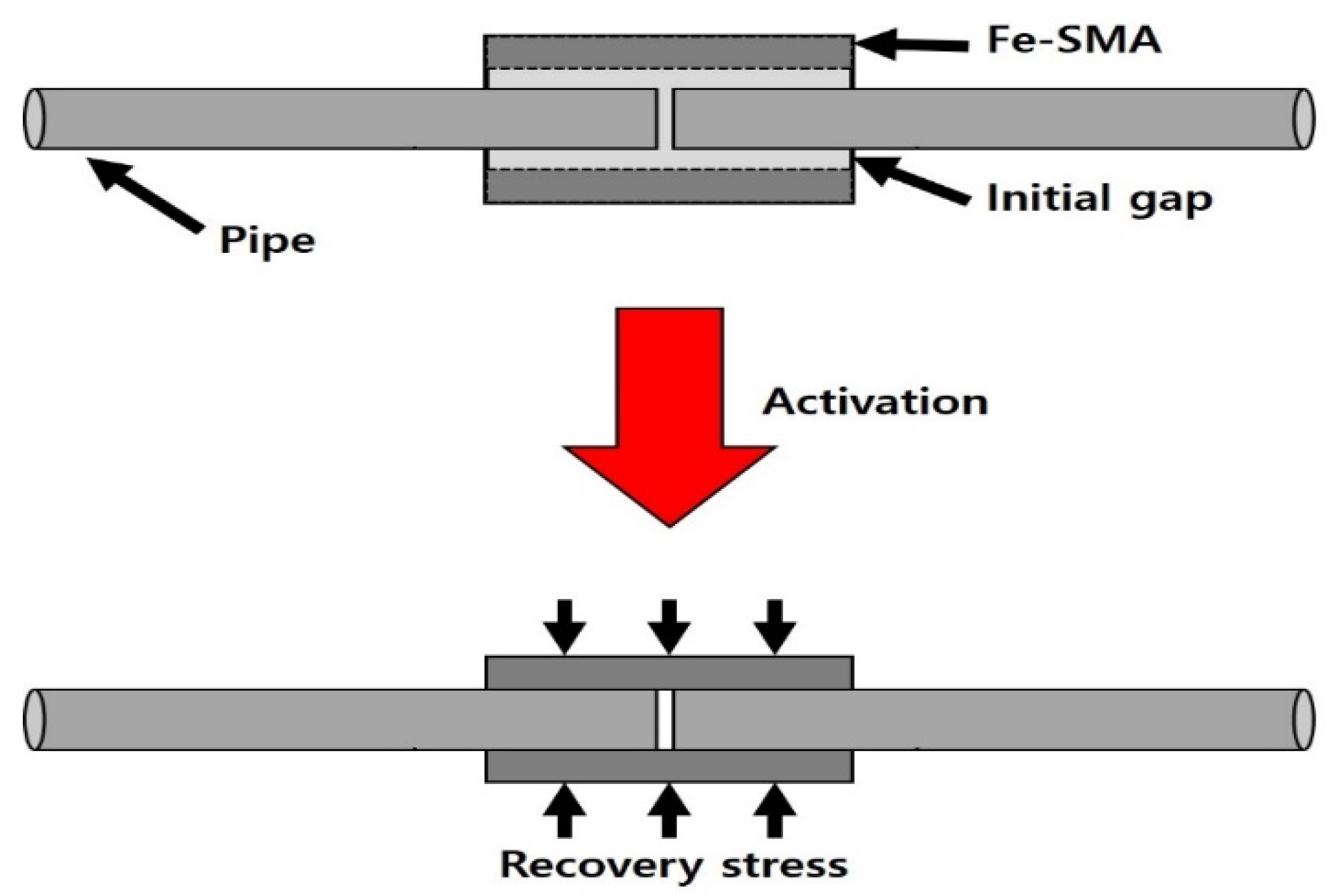
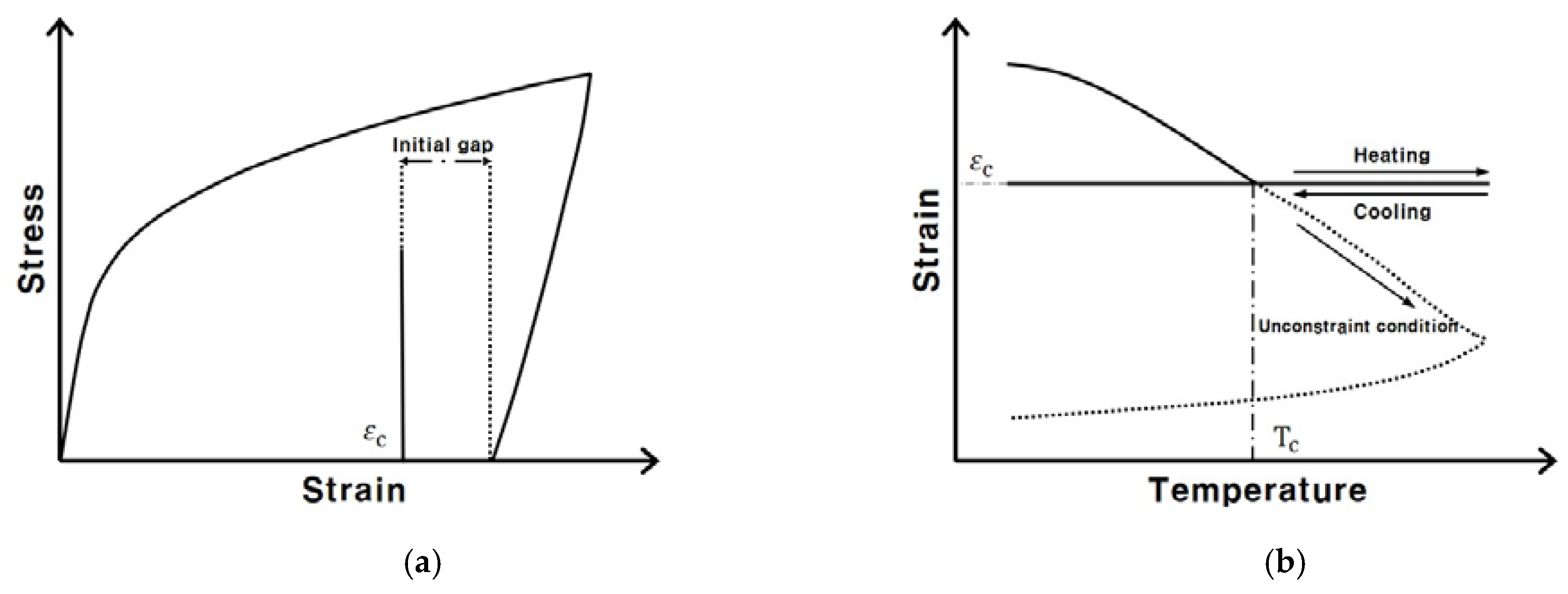
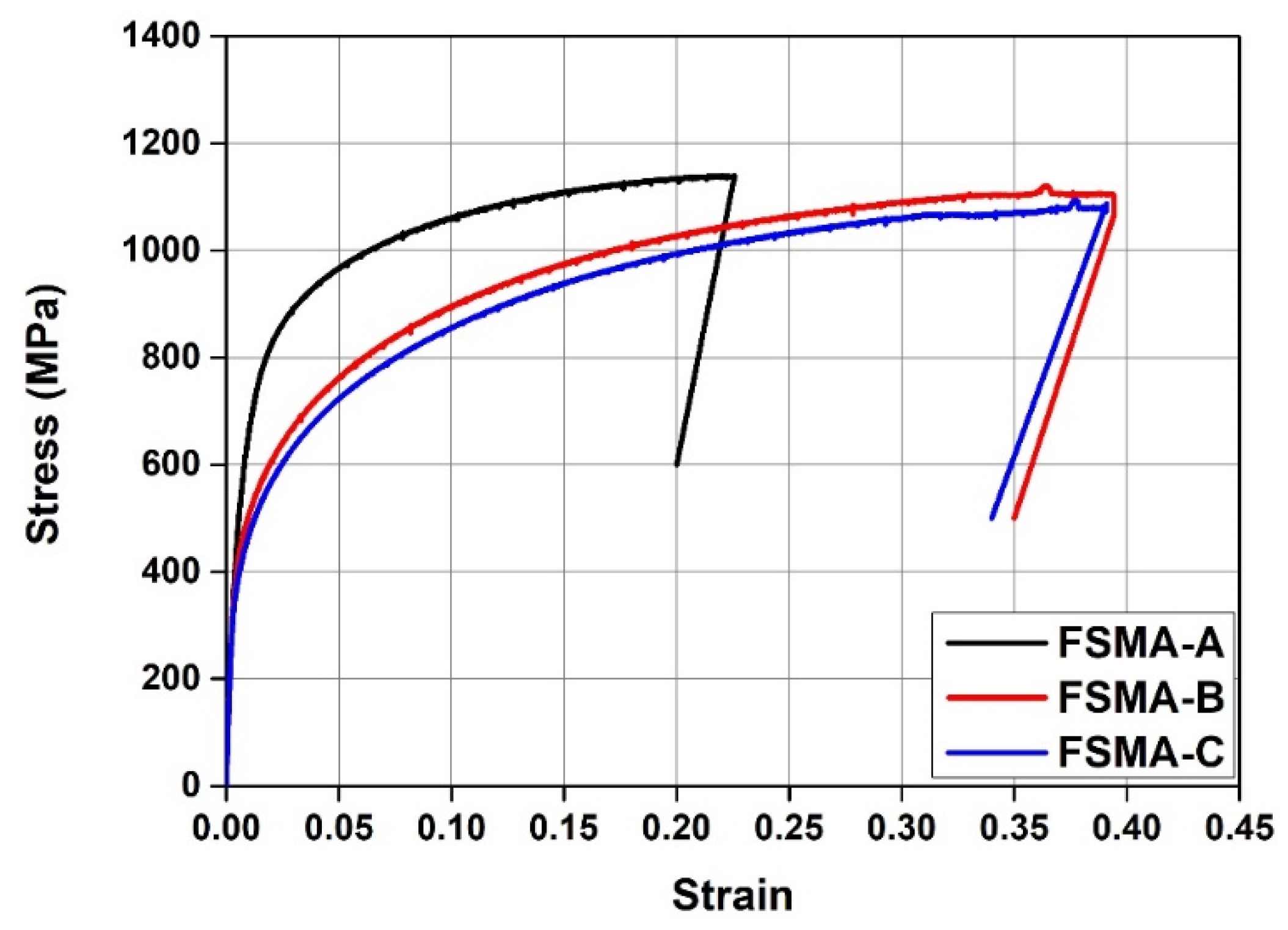
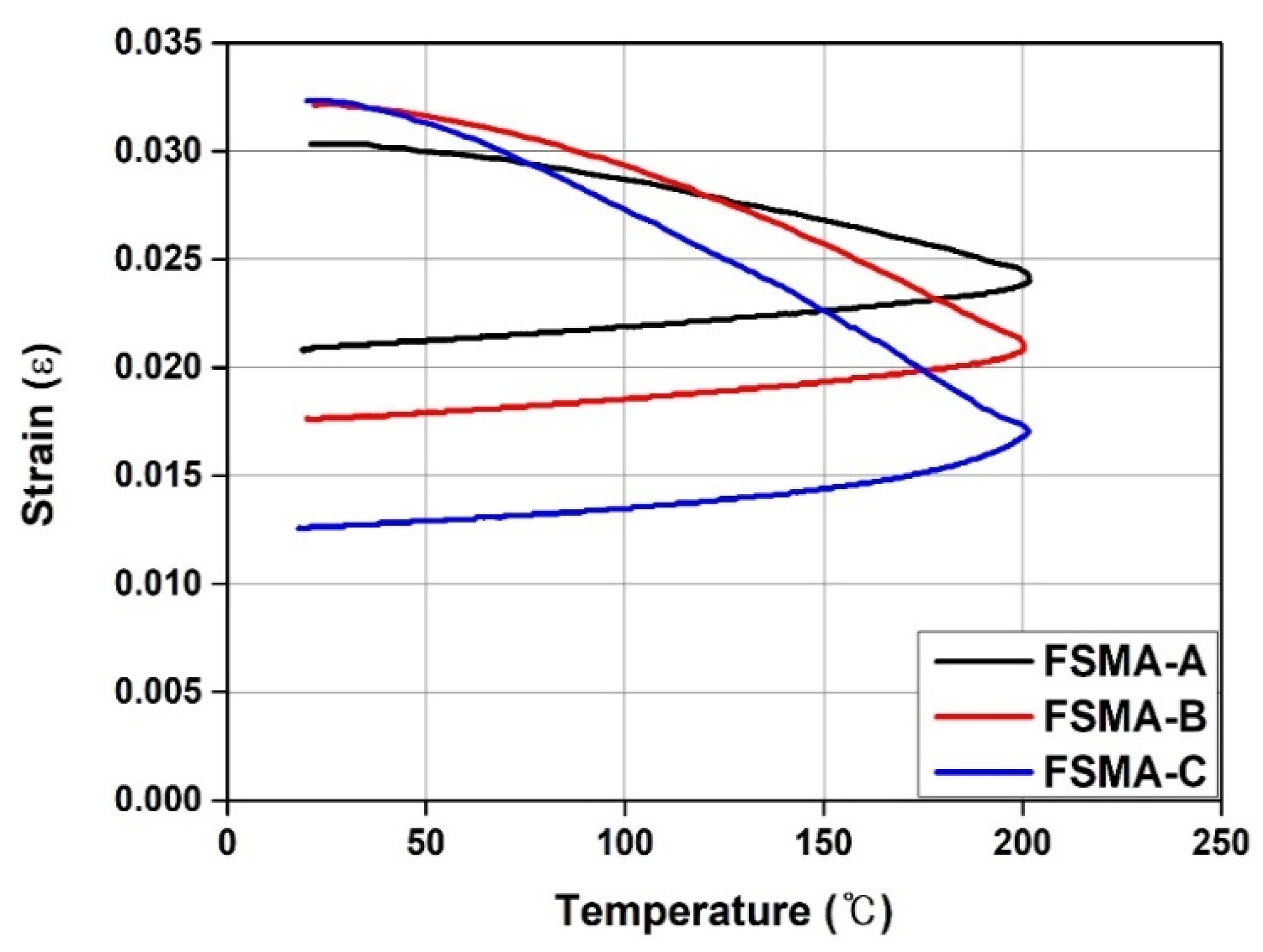
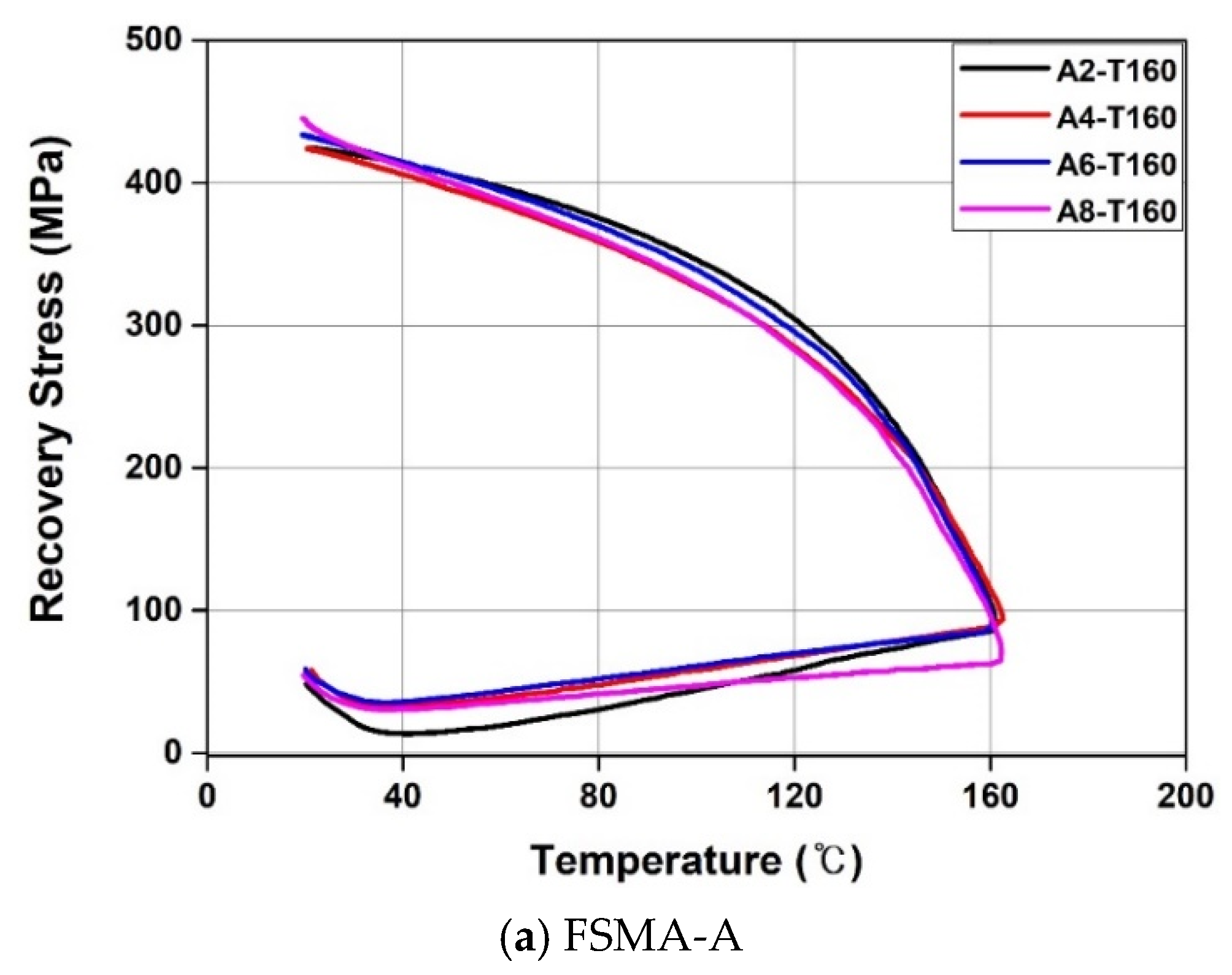
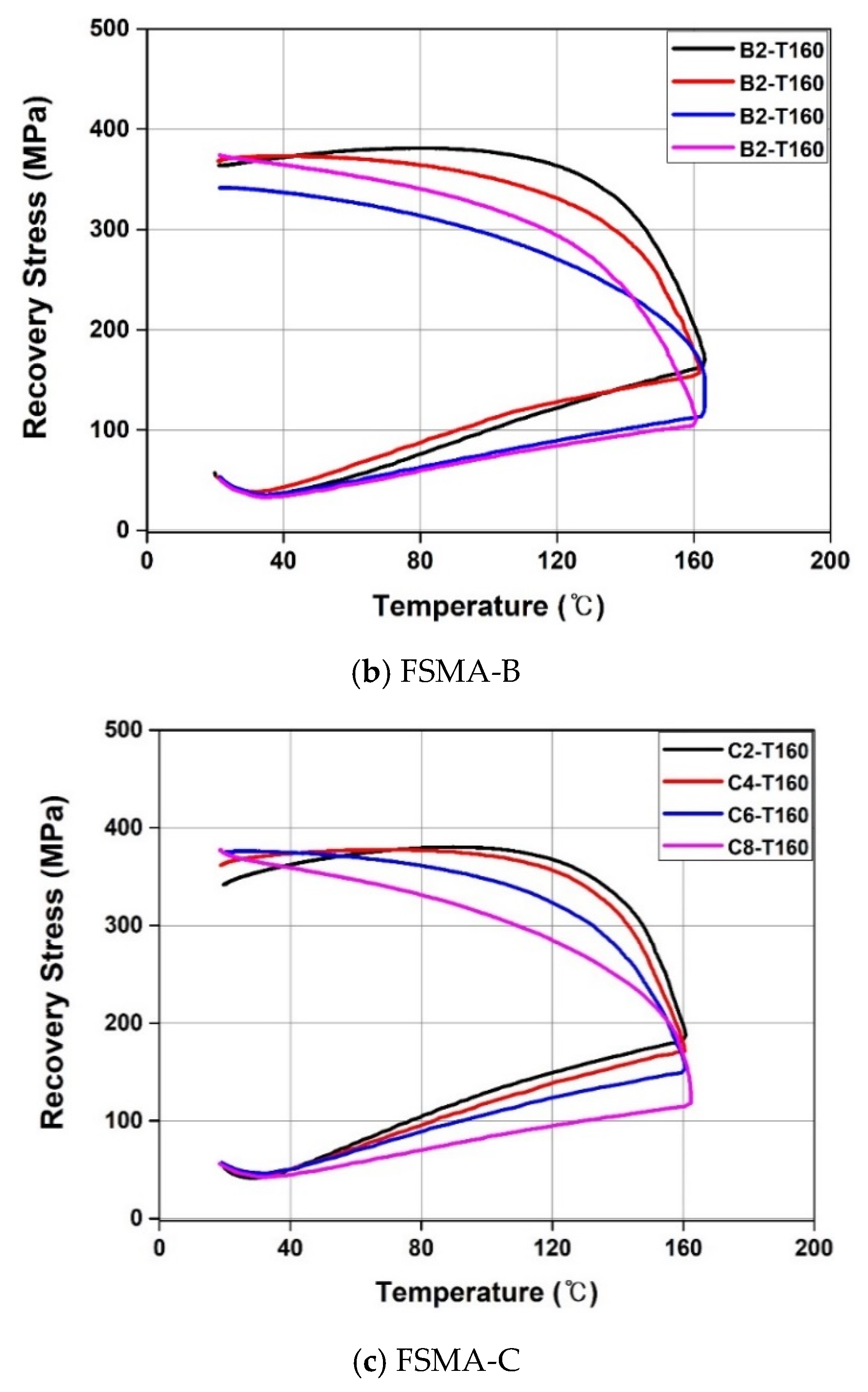
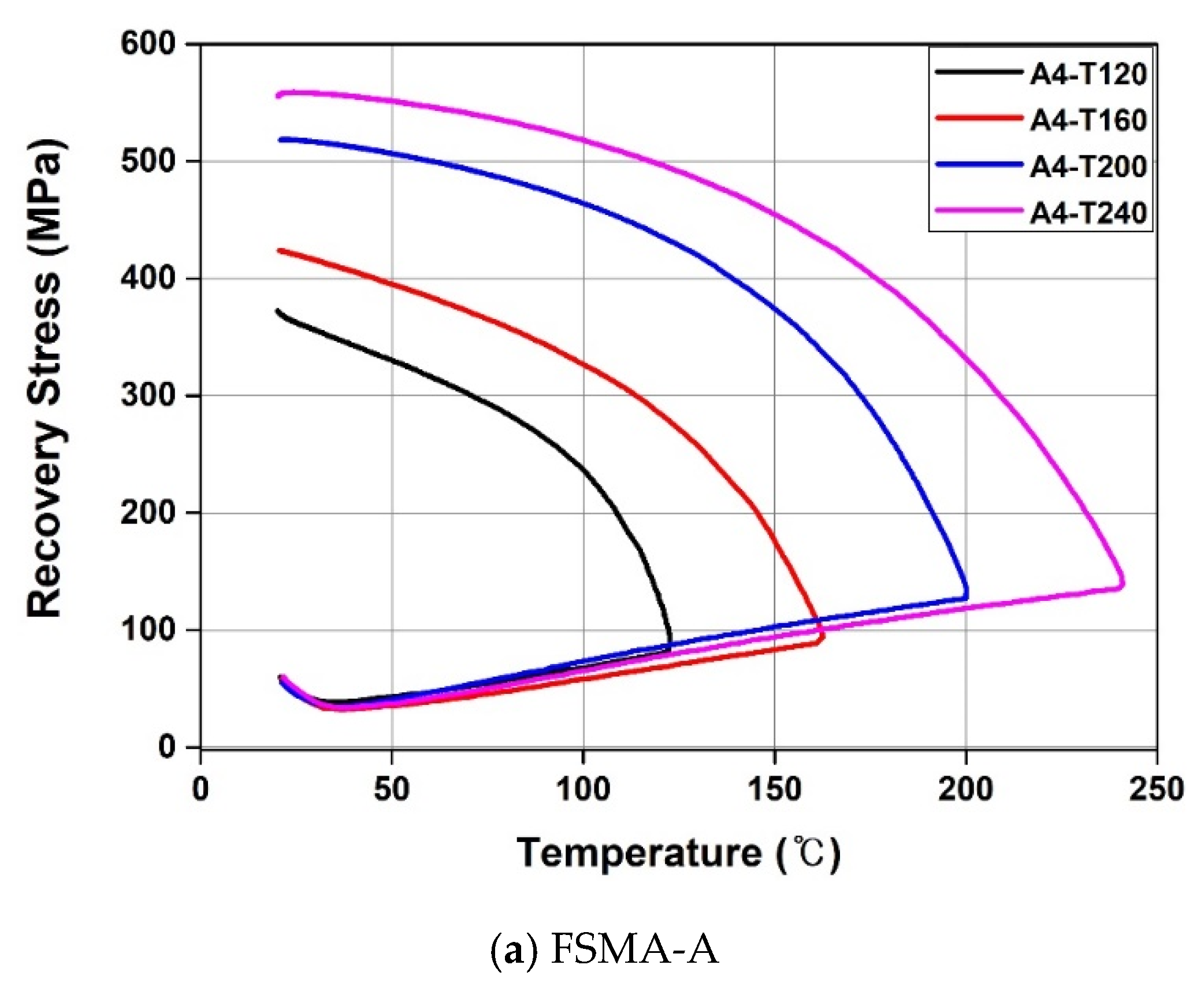
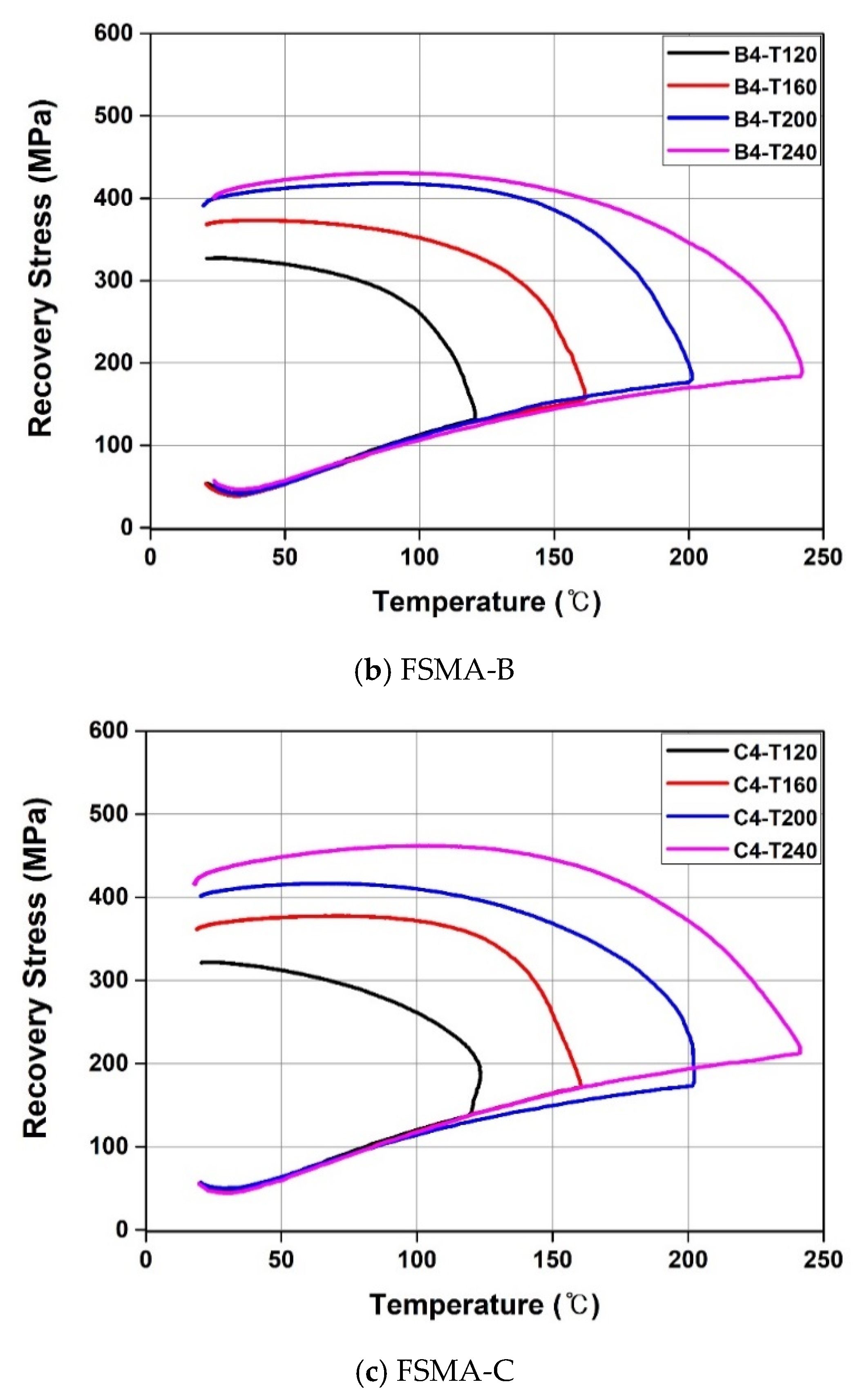


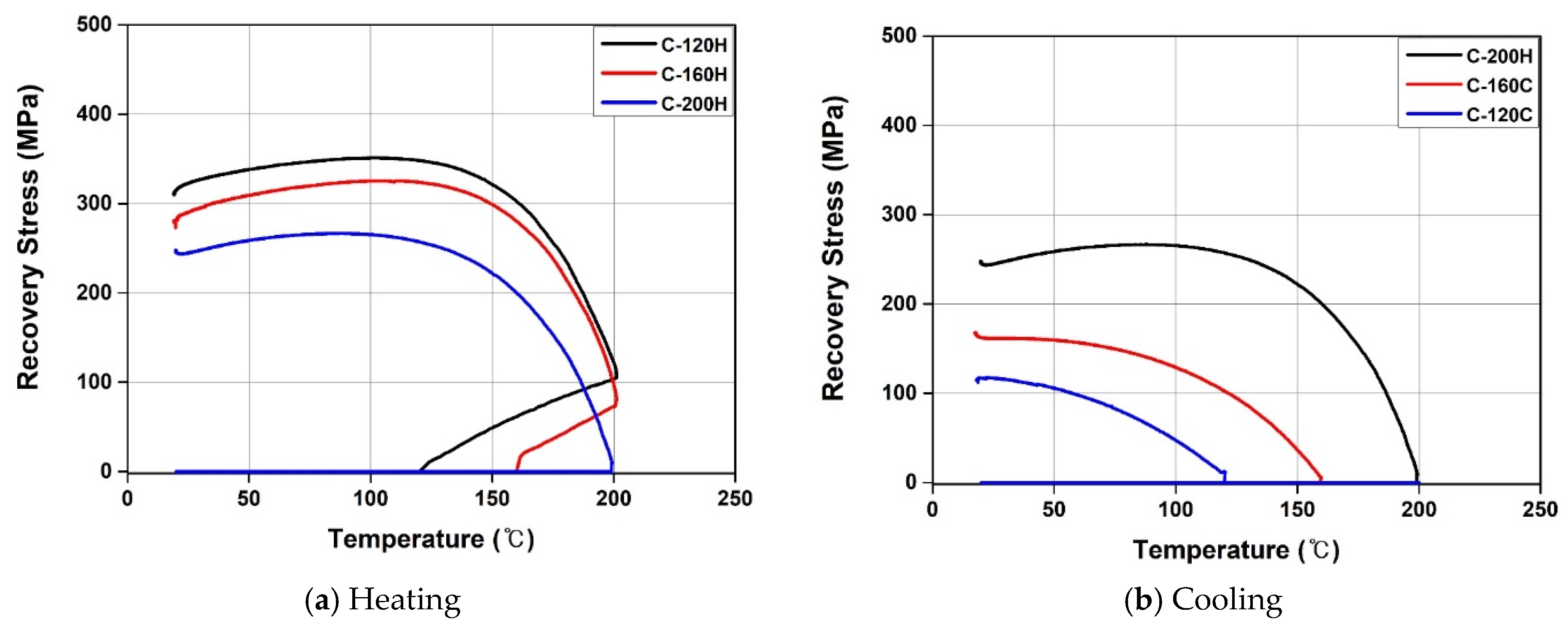


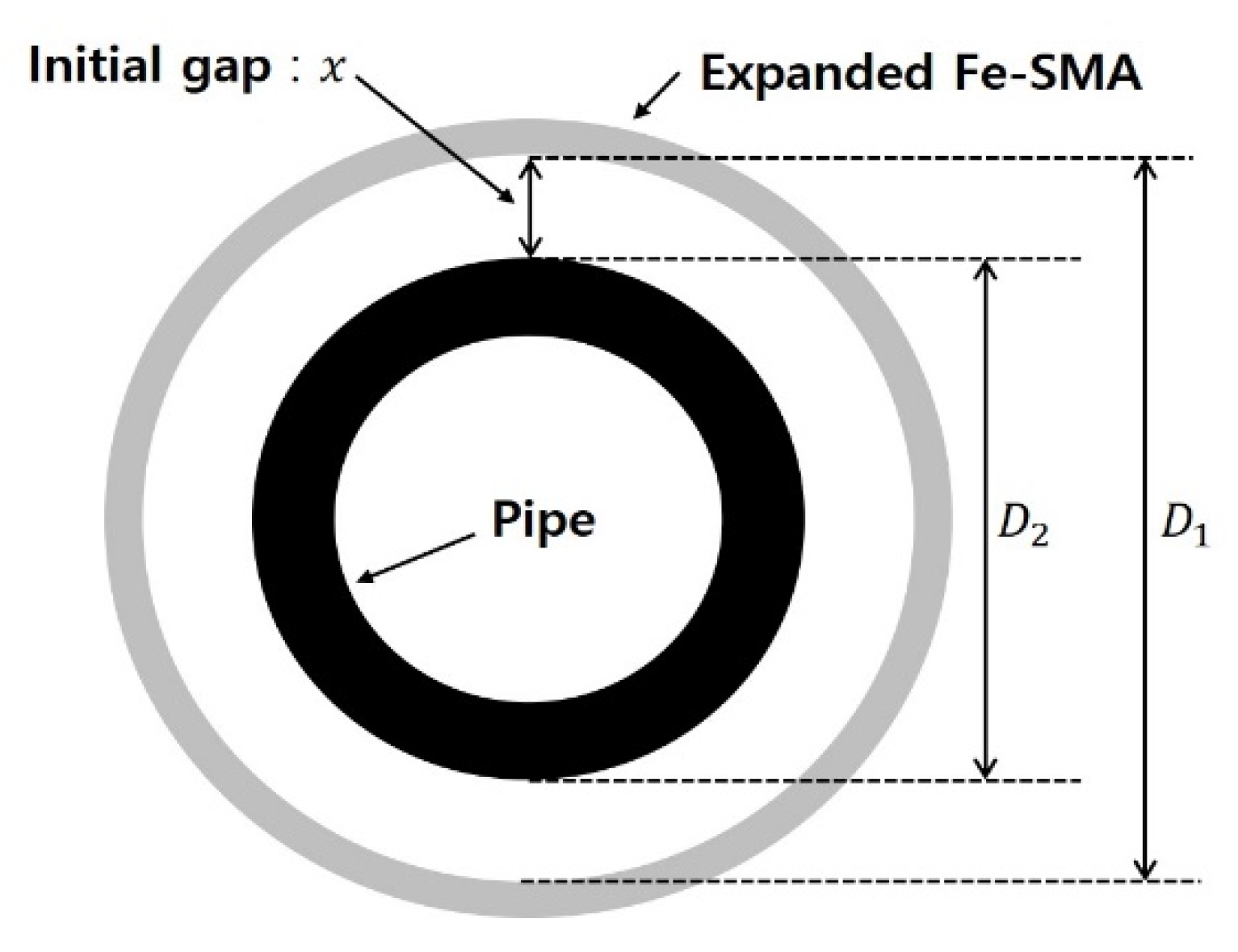
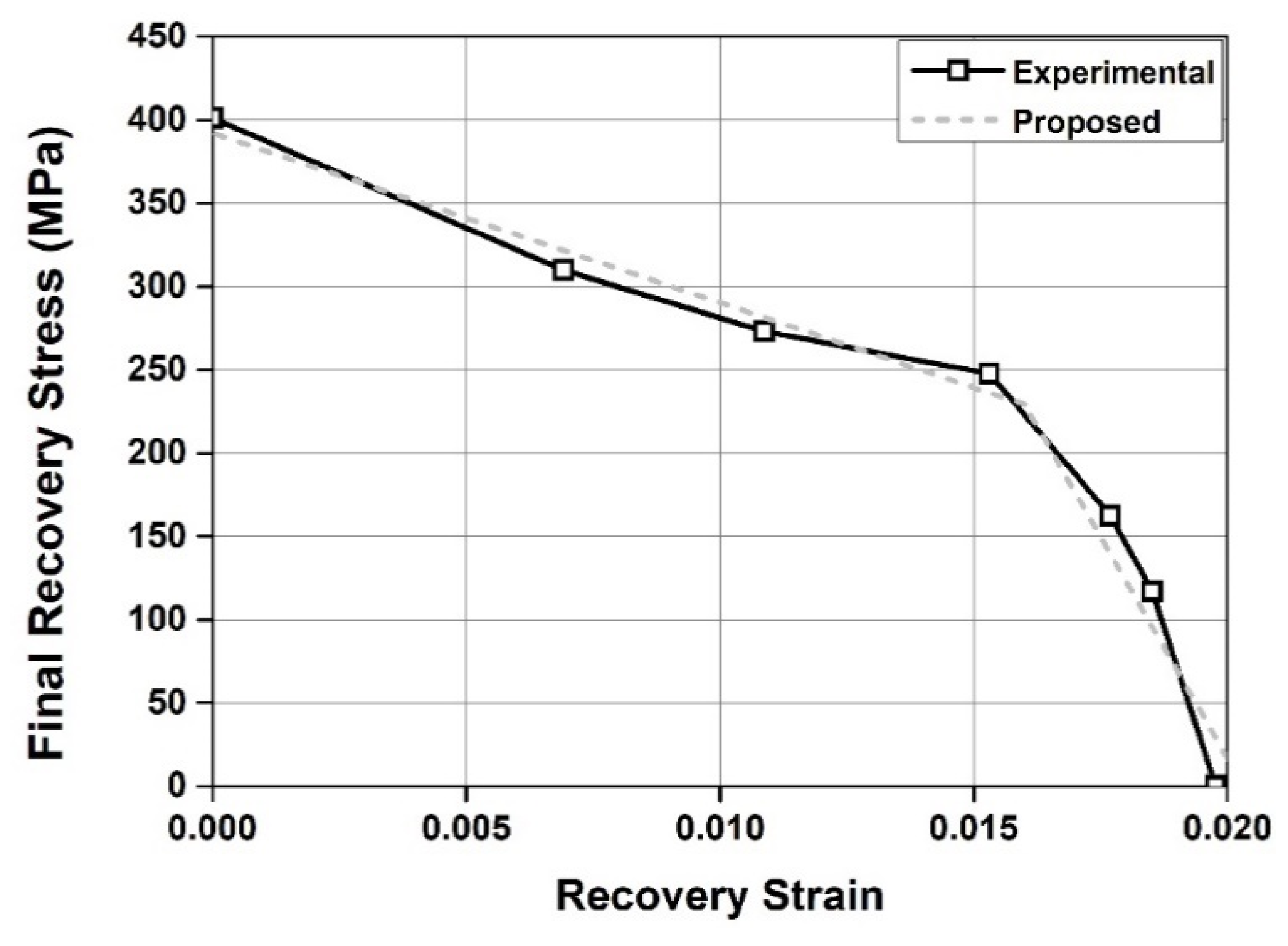
| Type of SMA | Chemical Composition (Weight %) | Heat Treatment |
|---|---|---|
| FSMA-A | Fe-17Mn-5Si-5Cr-0.3C-1T | Non-heat treated |
| FSMA-B | Fe-17Mn-5Si-5Cr-4Ni-0.1C | Non-heat treated |
| FSMA-C | Heat treated |
| Specimen | Type of SMA | Pre-Strain | Heating Temperature (°C) | |||
|---|---|---|---|---|---|---|
| A2-T160 | FSMA-A | 0.02 | 160 | 93 | 424 | 424 |
| A4-T120 | 0.04 | 120 | 90 | 372 | 372 | |
| A4-T160 | 0.04 | 160 | 97 | 424 | 424 | |
| A4-T200 | 0.04 | 200 | 136 | 519 | 518 | |
| A4-T240 | 0.04 | 240 | 139 | 559 | 555 | |
| A6-T160 | 0.06 | 160 | 96 | 434 | 433 | |
| A8-T160 | 0.08 | 160 | 73 | 445 | 445 | |
| B2-T160 | FSMA-B | 0.02 | 160 | 170 | 381 | 364 |
| B4-T120 | 0.04 | 120 | 132 | 327 | 327 | |
| B4-T160 | 0.04 | 160 | 157 | 373 | 368 | |
| B4-T200 | 0.04 | 200 | 180 | 418 | 391 | |
| B4-T240 | 0.04 | 240 | 189 | 431 | 401 | |
| B6-T160 | 0.06 | 160 | 124 | 342 | 341 | |
| B8-T160 | 0.08 | 160 | 110 | 374 | 374 | |
| C2-T160 | FSMA-C | 0.02 | 160 | 188 | 380 | 342 |
| C4-T120 | 0.04 | 120 | 154 | 322 | 321 | |
| C4-T160 | 0.04 | 160 | 171 | 377 | 362 | |
| C4-T200 | 0.04 | 200 | 189 | 416 | 401 | |
| C4-T240 | 0.04 | 240 | 213 | 462 | 416 | |
| C6-T160 | 0.06 | 160 | 153 | 376 | 375 | |
| C8-T160 | 0.08 | 160 | 118 | 377 | 377 |
| Specimen | Type of SMA | Constraint Temperature (°C) | Strain at Constraint Point | Recovery Strain at Constraint Point | ||
|---|---|---|---|---|---|---|
| A-120H | FSMA-A | 120(Heat) | 0.02791 | 0.00242 | 399 | 396.01 |
| A-160H | 160(Heat) | 0.02632 | 0.00401 | 347 | 347 | |
| A-200H | 200(Heat) | 0.02406 | 0.00627 | 302 | 298 | |
| A-160C | 160(Cool) | 0.02281 | 0.00752 | 173 | 173 | |
| A-120C | 120(Cool) | 0.02215 | 0.00818 | 114 | 114 | |
| C-120H | FSMA-C | 120(Heat) | 0.02543 | 0.00692 | 351 | 310 |
| C-160H | 160(Heat) | 0.02147 | 0.01088 | 325 | 273 | |
| C-200H | 200(Heat) | 0.01703 | 0.01531 | 267 | 248 | |
| C-160C | 160(Cool) | 0.01465 | 0.01769 | 168 | 163 | |
| C-120C | 120(Cool) | 0.01382 | 0.01852 | 118 | 117 |
| Type of SMA | Yield Strain | Yield Stress (MPa) | Ultimate Strain | Ultimate Stress (MPa) | Elastic Modulus (GPa) |
|---|---|---|---|---|---|
| FSMA-A | 0.00666 | 599 | 0.22556 | 1140 | 125 |
| FSMA-B | 0.00496 | 380 | 0.39369 | 1105 | 126 |
| FSMA-C | 0.00530 | 410 | 0.39510 | 1080 | 123 |
| Type of SMA | Residual Strain | Strain at 200 °C | Strain after Activation | Recovery Strain |
|---|---|---|---|---|
| FSMA-A | 0.03033 | 0.02406 | 0.02077 | 0.00956 |
| FSMA-B | 0.03214 | 0.02103 | 0.01769 | 0.01445 |
| FSMA-C | 0.03234 | 0.01703 | 0.01257 | 0.01977 |
© 2020 by the authors. Licensee MDPI, Basel, Switzerland. This article is an open access article distributed under the terms and conditions of the Creative Commons Attribution (CC BY) license (http://creativecommons.org/licenses/by/4.0/).
Share and Cite
Hong, K.-N.; Yeon, Y.-M.; Shim, W.-B.; Kim, D.-H. Recovery Behavior of Fe-Based Shape Memory Alloys under Different Restraints. Appl. Sci. 2020, 10, 3441. https://doi.org/10.3390/app10103441
Hong K-N, Yeon Y-M, Shim W-B, Kim D-H. Recovery Behavior of Fe-Based Shape Memory Alloys under Different Restraints. Applied Sciences. 2020; 10(10):3441. https://doi.org/10.3390/app10103441
Chicago/Turabian StyleHong, Ki-Nam, Yeong-Mo Yeon, Won-Bo Shim, and Do-Hyung Kim. 2020. "Recovery Behavior of Fe-Based Shape Memory Alloys under Different Restraints" Applied Sciences 10, no. 10: 3441. https://doi.org/10.3390/app10103441
APA StyleHong, K.-N., Yeon, Y.-M., Shim, W.-B., & Kim, D.-H. (2020). Recovery Behavior of Fe-Based Shape Memory Alloys under Different Restraints. Applied Sciences, 10(10), 3441. https://doi.org/10.3390/app10103441





